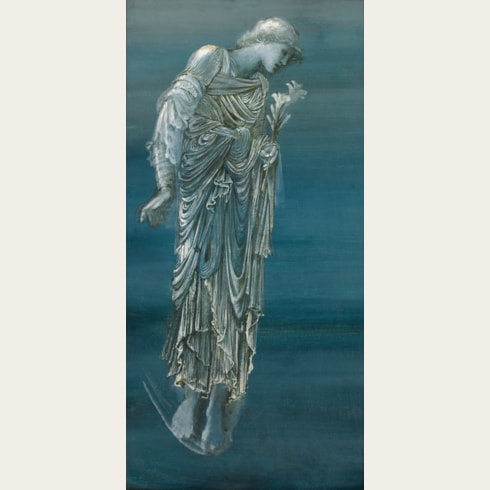Edward Coley BURNE-JONES
(Birmingham 1833 - London 1898)
Study of the Torso and Right Leg of a Man
282 x 137 mm. (11 1/8 x 5 3/8 in.)
The leading member of the second generation of Pre-Raphaelite painters, Edward Burne-Jones studied at Exeter College, Oxford, where he met William Morris. The two were to remain lifelong friends and colleagues, with Burne-Jones executing designs for stained glass windows, ceramic tiles and tapestries for Morris and Company for more than thirty-five years. Another close friend was Dante Gabriel Rossetti, who gave Burne-Jones some of the little artistic training he received, otherwise being largely self-taught. From early in his career Burne-Jones enjoyed a measure of success, particularly as a designer of stained glass panels. In 1859 he made the first of four trips to Italy, a country whose art he found of considerable inspiration throughout his life. In 1877 he showed a total of eight paintings at the inaugural exhibition at the Grosvenor Gallery, established as a more radical alternative to the Royal Academy. The success of these pictures, and his continued participation in the yearly Grosvenor exhibitions, established Burne-Jones's reputation as a leader of the Aesthetic movement. His fame also spread to Europe, and in particular Paris, where his painting of King Cophetua and the Beggar Maid was greatly admired at the Exposition Universelle of 1889.
A passionate and prolific draughtsman, Burne-Jones produced countless preparatory studies and cartoons for his paintings, as well as drawings intended as independent works of art in their own right, in black and red chalk, pencil, pen and watercolour. His drawings were, indeed, of arguably greater significance to him than his finished paintings; as John Christian has noted, Burne-Jones ‘was always a draughtsman first and a painter second.’ Similarly, the artist’s friend Graham Robertson wrote that ‘He was pre-eminently a draughtsman, and one of the greatest in the whole history of Art…as a master of line he was always unequalled; to draw was his natural mode of expression – line flowed from him almost without volition.’ Although he occasionally gave drawings away as presents, and also sometimes exhibited them in public, Burne-Jones seems to have kept most of his drawings in his studio until his death, after which they were dispersed.










